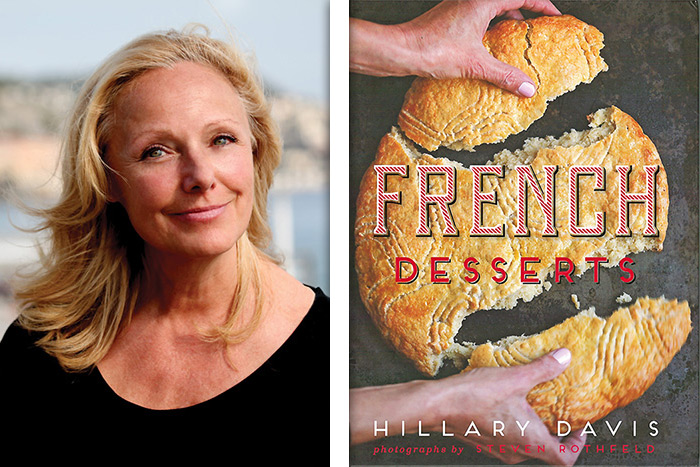Hamptons Epicure: Simply the Best – 'French Desserts' Cookbook by Hillary Davis

The publishing house Gibbs Smith realized its mission to “enrich and inspire humankind” anew with its recent release of Sagaponack author Hillary Davis’s fourth cookbook, French Desserts.
Some of the best French desserts are not complicated. As Davis says, “I wanted to emphasize that French cooking is home cooking.” This book caps that idea—it’s the ultimate dessert course. Davis’s previous releases have given us books full of Cuisine Nicoise, French Comfort Food and hearty dishes prepared in Le French Oven.
Davis’s enthusiasm for her subject is apparent in this tome’s every detail. Her American practicality meets her sophisticated French sweet tooth and the result is kitchen alchemy. As Davis writes, “I divide each chapter, first into the recipes that are quicker to make, followed by the recipes that take longer to make. And, for the few fancier creations, I worked to demystify the magic of making them” for the home cook. She reduces the popular Millefeuille (“a thousand leaves”) down to two sheets of puff pastry.
Davis also includes a recipe that produces just one cookie—the very large communal cookie, Le Broyé du Poitou, depicted on the book’s cover at right. Davis shares that “In 2004 a group called La Confrérie de l’Ordre des Chevaliers de la Grand Goule formed to protect and promote the tradition of making of this giant cookie, a specialty of the Poitou-Charentes region of France. It’s a cookie worth protecting and promoting…it may be my favorite cookie of all time.” And Davis’s recipe for it calls for only six ingredients and this “piece” of advice: “To serve, present the whole cookie and let people break off pieces like they do in Poitiers.” (See recipe below.)
And, yes, of course a recipe for madeleines is included. Davis points out that this Proustian memory prompter is, however, “technically not a cookie” but rather a small cake that first gained popularity in Louis XV’s court at Versailles.

Davis lived in France for 13 years and clearly paid close attention to the details—and she copied down recipes from her neighbors, friends, local restaurants, farmers markets and inn keepers.
Hers is an approach that honors the traditional but is open to tasteful improvisation. Her recipe for Les Lunettes à la Confiture fillings includes this persuasive note: “Why not try peanut butter and jelly? Or lemon curd? On Valentine’s Day, cut out hearts instead of eyeglasses, at Christmas cut out trees. Make them with different colors and flavors of jam.” And this joyous note regarding Fresh Fruit Papillotes—“Approach the recipe with abandon, picking any seasonal fruit you may find and adding in fresh herbs from your garden if you wish.” Other recipes include “Chocolate Drizzle,” “Swirly Marshmallows” and “Crazy Chocolate Loaf Cake!”
Inspiration and seasonality are important, but ingredients also make the dish. As Davis asserts, “you should do as the French do and use nothing but the best.” Adding, “always use pure extracts as imitation extracts impart an unpleasant flavor and defeat the purpose of making a wonderful-tasting dessert.” And then she offers a recipe for making your own vanilla extract at home.
No doubt East Enders will be happy to follow her direction to “please use large eggs unless otherwise noted, preferably organic or free range” from our local farms.
Davis’s welcoming hospitality and generosity are on display on every page and the photographs by Steven Rothfeld (author of the recently released Israel Eats) add a gorgeous visual dimension to the work.
So rev up your culinary blowtorch and remember—“Vive la France!”

GIANT BREAK-AND-SHARE COOKIE
Le Broyé du Poitou
Quick | Makes 1 Cookie
In 2004 a group called the La Confrérie de l’Ordre des Chevaliers de la Grand Goule formed to protect and promote the tradition of making of this giant cookie, a specialty of the Poitou-Charentes region of France. It’s a cookie worth protecting and promoting. Recognizable by its crisscross pattern made with a fork across the top, and by its great size, it is a communal cookie, brought out for people to share after mass, baptisms, weddings, community dinners, and even inaugurations. Once I heard about it, I had to try to find a recipe. This one is adapted from the official recipe on the Confrérie’s web site. I can’t stop eating it, and I have to admit it may be my favorite cookie of all time. It tastes a lot like shortbread, and is great dipped into tea or with a glass of milk.
Special Equipment:
food processor; 1 baking sheet
3 3⁄4 cups sifted all-purpose flour
1 1⁄4 cups granulated sugar
1⁄2 teaspoon salt
2 sticks plus 2 tablespoons salted chilled butter, cut into small cubes
1 large egg
3 tablespoons dark rum
1 large egg yolk
Preheat the oven to 350 degrees F. Place the flour, sugar, and salt in the bowl of a food processor and pulse 6 times.
Add the butter and process until the mixture is granular in texture. Whisk the egg and rum in a small bowl, add to the food processor, and process just until a ball forms. If it is still too dry to form a ball, add 1 tablespoon of ice water at a time until it comes together into a ball.
Place the dough on a large piece of plastic wrap. Press it down into a circle with the palms of your hands. Transfer to the baking sheet, removing and discarding the plastic wrap, and continue shaping and pressing the disk until it is 1⁄2 inch thick and approximately 10–11 inches across. Pinch all the way around the edges to create a decorative wave pattern.
Beat the egg yolk and brush it across the top and down the sides.
Drag the tines of a fork from one end to the other several times to create a large crisscross pattern.
Bake for 25–35 minutes, until golden brown.
Allow to cool for at least 20 minutes on the baking sheet then carefully slip it off onto a large round plate.
To serve, present the whole cookie and let people break off pieces like they do in Poitiers.
Tip: Some families scatter slivered almonds over the top before baking. You can also form this dough into mini or individual 1⁄2-inch-thick cookies if you wish.
Photography by Steven Rothfeld from French Desserts by Hillary Davis, reprinted by permission of Gibbs Smith.



